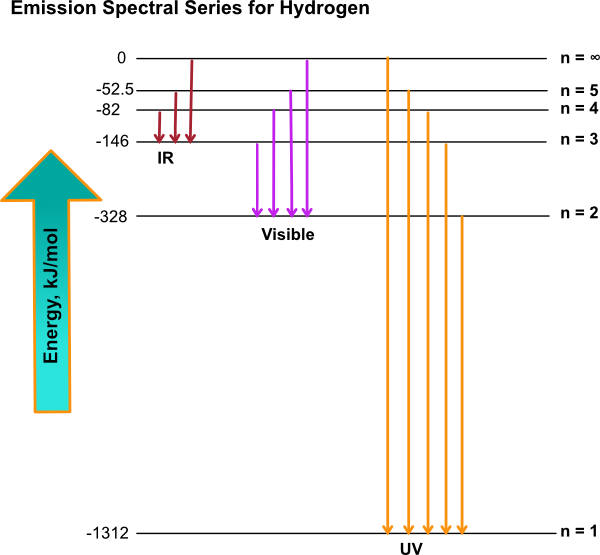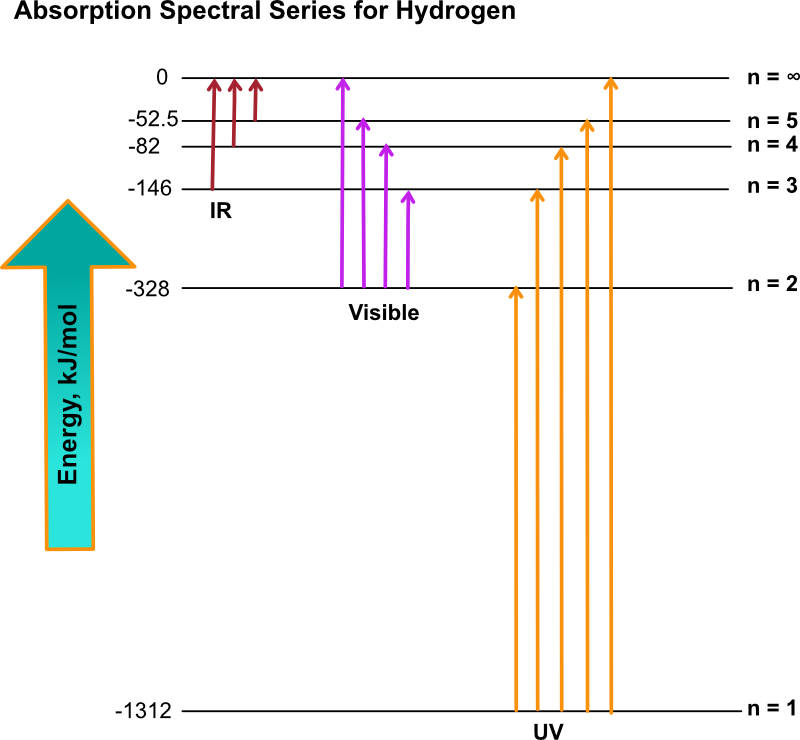In the last study guide we learned that electromagnetic radiation has both wave and particle properties. In this study guide we will discuss how light and matter interact. The light we see from the sun or from a lightbulb is called white light because it consists of all the colors in the visible spectrum. It will produce a continuous spectrum of all colors from violet to red. There are no gaps in a continuous spectrum as can be seen in the figure below.
In fact, raindrops will disperse sunlight into a rainbow. Not all light sources will produce a continuous spectrum.

“Europa Rainbow” by Robert Couse-Baker is licensed with CC BY 2.0. To view a copy of this license, visit https://creativecommons.org/licenses/by/2.0/
If hydrogen gas is placed into a discharge tube, and a high voltage is applied, the result is 4 different colored lines. This is called a line spectrum which consists of radiation of specific wavelengths. The spectrum is not continuous and only has four different colors. The colors in the hydrogen emission spectrum correspond to wavelengths of 410.1, 434.1, 486.1, and 656.3 nm.
The line spectra below are for lithium and sodium. We see that sodium has two yellow lines that are typical of some street lights. When heated, elements will produce line spectra. Fireworks are made up of metal salts that when heated will produce light of different colors. Each element has its own line spectrum and a line spectrum can be used to identify different elements. The line spectrum is like a fingerprint and is specific for each element.
If you have ever let food boil over when cooking, you will notice the gas flame will turn a bright yellow-orange. This is due to the electrons in the sodium atoms gaining energy and then emitting the energy as yellow light. We will discuss this in more detail later in the study guide. For now we will focus on hydrogen.
Rutherford’s model stated the atom was made up of a dense positively charged nucleus with negatively charged electrons in the extranuclear region. There was a problem with this model. According to classical physics, if an electron was orbiting a nucleus, it would continuously lose energy in the form of electromagnetic radiation. The electron would spiral into the nucleus within about 10-10 s. The stability of the atom could not be explained by this theory.
J.J. Balmer, in 1885, showed the wavelengths in the visible region of the hydrogen atom could be determined by the following equation:
where n is an integer greater than 2. If we substitute 3 for n, we get 6.56 x 10-7 m which is a wavelength of 656 nm. This wavelength corresponds to red light. Substituting 4, 5, and 6 for n will give the other three lines in the visible spectrum for the hydrogen atom.
A Danish physicist, Niels Bohr (1885 – 1962), used the work of Planck and Einstein to apply a model to explain the stability and the line spectrum of a hydrogen atom. Bohr’s postulates follow:
2. The electron’s energy remains constant as long as it stays within a stationary state.
3. The electron can only change to another stationary state by absorbing or emitting a photon. The energy of the photon is equal to the differences in the energies of the two states.
Bohr derived the following formula for the energy levels in a hydrogen atom:
RH is a constant, in energy units, equal to 2.179 x 10-18 J. The energies of the electron in the hydrogen atom can be calculated by putting in integer values for n; n = 1, 2, 3, 4, … ∞.
When an electron is in a higher energy level and falls to a lower energy level, light is emitted. This is shown in the figure below. The emission lines are for the electron in the hydrogen atom. The figure shows the Lyman Series (ultraviolet region), the Balmer Series (visible region) and the Paschen Series (infrared region). Bohr was able to predict all of the lines in the hydrogen atom spectrum including those in the ultraviolet and infrared region. When an electron is in a higher energy level and it falls to a lower energy level, the energy is emitted as light. We say the electron has undergone a transition.
Notice, in the figure above the energies have a negative sign. At n = ∞, the electron has been completely removed from the nucleus and is assigned zero energy. The ionization energy is the energy required when the electron has been completely removed from a hydrogen atom, at n = ∞. The further the electron is from the nucleus, the higher the energy. The closer the electron is to the nucleus, the lower the energy. The more negative the value of energy, the closer the electron is to the nucleus.
From the law of Conservation of Energy, the final energy of the electron, Ef plus the energy of the photon, hν, is equal to the initial energy of the electron, Ei:
Equation 1 can be rearranged to:
Bohr obtained Balmer’s equation by substituting ni for the principle quantum number of the initial energy level, and nf for the principle quantum number of the final energy level into Equation 2.
Rearranging the equation:
We know that ν = c/λ and the equation can be rewritten as:
We calculate RH/hc as:
This is the same constant as in the Balmer formula where nf = 2. This gives the four wavelengths in the visible region. If we change nf to equal 1, we get the lines in the ultraviolet series and when nf = 3, we get the wavelengths in the infrared series for the hydrogen atom.
We now ask how the electron in a hydrogen atom gets to a higher energy level. The electron must gain energy to get from a lower to a higher energy level. One way this can happen is through collisions between hydrogen atoms. If a collision is forceful enough, the electron in an atom can gain enough energy to transition to a higher energy level. The most common way is in a hot gas. A gas has a very high kinetic energy, and an electron can be excited to a higher state. The electron in a hydrogen atom usually resides in the lowest energy state, n = 1. When the electron gains energy it goes to a higher energy level, n, in a process called absorption. Eventually the electron will release the energy, as light, as it goes from a higher energy level to a lower energy level. This is called emission. Below is an absorption spectral series for the electron in a hydrogen atom.
A transition for an electron in the hydrogen atom from n = 1 → n = 3 would be absorption of energy. A transition from n = 4 → n = 2, would be emission of energy. Bohr was able to explain both emission and absorption for an electron in the hydrogen atom. Bohr’s postulates do not work well for atoms that have more than one electron. In multi-electron species, there are electron repulsions, and the energy levels cannot be determined by one simple equation. Although, in a multi-electron atom, if we know the wavelength of the emitted or the absorbed light, it can be related to the frequency and then finally to the energy differences between energy levels.
Worksheet: Bohr’s Model: Matter Waves
Watch the following video (Start at 32:27 minutes) for a discussion on the Bohr model and line spectra.
Exercises
Exercise 1. Calculate the energy of the electron in the hydrogen atom if the electron is excited from n = 2 to n = 6. Calculate the wavelength when the electron transitions from n = 6 to n = 2.
Exercise 2. Indicate if energy is absorbed or emitted for the following electron transitions:
b) n = 3 → n = 1
c) from an orbit of radius 1.46 Angstroms to an orbit with radius of 0.768 Angstroms.
Exercise 3. What is the energy, in kJ/mol, for an electron that transitions from n = 1 to n = ∞? This is the ionization energy for the hydrogen atom. Is the energy absorbed or emitted?
Exercise 4. Calculate the wavelengths for the three lines in the infrared region of the hydrogen spectrum.
Check Solutions/Answers to Exercises
Back to Electronic Structure of Atoms
Back to General Chemistry 1 Study Guides
Back to Home Page






